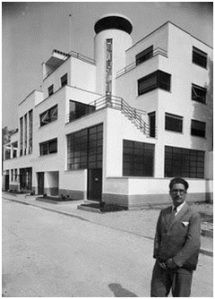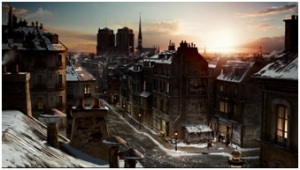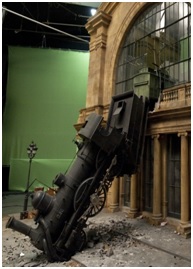THE MADA SHORT ARCHITECTURAL FILM PROGRAM 2014: PROGRAM NOTES
“IT’S A KENNEDY”: Melbourne, the Cinema and the work of Chris Kennedy.
ACMI MEDIATHEQUE PROJECT: The Shape & Form of Home [Melbourne + Beyond]
THE REPRESENTATION OF ARCHITECTURE IN FILM and THE CINECITY PROJECT
ARCHITECTURE, FILM & MUSIC: ACMI Mediatheque Project
[click titles above to view texts]
THE MADA SHORT ARCHITECTURAL FILM PROGRAM 2014: PROGRAM NOTES
ARCHITECTURE & FILM
The exploration of the lived experience of the city through cinematic constructions is one of the many possible approaches to the study of film and architecture. Storytelling is a significant key in understanding aspects of architecture and the city. The possibility of narrative within film activating unspoken narratives of architecture and the city provides exciting opportunities for understandings the city in terms of our relationship to it through our senses and, the material and immaterial aspects of experience.
Image credit: HUGO still (2011) Martin Scorsese
# # #
CARS CINEMA CITY
This image above is a still from HUGO, the Martin Scorsese film of 2011.It makes a useful reference point in thinking about the inter-relationships between film and architecture. This image, the particular still, and the context from which it is taken, the film HUGO, points towards many of the themes which are explored through this program of short films: modernity, the city, transport, home, the constant inter-change between the real and fictive and the cinema itself.
# # #
MODERNITY
The still contains much in terms of cinema history too. In the background, the black and white part of the image, what we are seeing is a part of one of the very first films ever made and screened. It’s from 1895 and it’s called L’ARRIVÉE D’UN TRAIN EN GARE DE LA CIOTAT (THE ARRIVAL OF A TRAIN AT LA CIOTAT STATION). It runs for less than a 1 minute, about 50 seconds.
The people we see in colour at the front of the HUGO still are a part of an early film history/ myth often referred to but apparently not readily confirmed. That is, the people watching the film in these early screenings thought the train was going to come of the screen and hit them[1]. The train and the cinema are both marvellous 19th century modern phenomena (marvellous: as in things marvel at people).
Image credit: L’ARRIVÉE D’UN TRAIN EN GARE DE LA CIOTAT still (1895 or 6 or7[2]) Lumiere Brothers
# # #
PARIS
The film HUGO, the context from which this still is taken, is a weird a sort of film, when you stop to think about it, but it’s a type we readily accept from Hollywood.
Image credit: HUGO still (2011) Martin Scorsese
HUGO is set and partly filmed in Paris; it’s made by an American director, with most of the star cast being English and it is an English language film – not a French film.
The story, time wise, is set in the 193os. The film is telling, in relation to what we know of Paris historically from this period, for what it leaves out and for what it includes. Part of the film’s workings in telling its particular story – of Paris, is that it is not so much a story of the people of Paris, the people who live there and experience this city as home; but it is a very particular view drawn from another modern phenomenon that of mass tourism.
This view of Paris, in the film HUGO, is one that belongs to those who travel to, or wish to travel to Paris. This view is a part of the imagery embedded within ideas of both the real and the fantastic which has drawn in us…and artists and writers, in large numbers, typically to places such as Montmartre in the 19th century and later to Montparnasse in the early part of the 20th century; and this is when and where the film HUGO is set, specifically it is set in the train station Gare Montparnasse. What’s left in the film HUGO is, a romantic, outsiders view of Paris, one that possibly really only fully exists in our ideas and images, in our minds, in postcards, in stories told to us, in films, in fleeting visits; but it is a Paris that is perhaps no less real than the Paris that we touch with our feet (for us as people who don’t live in Paris, but dream about and travel to it) this is for us – Paris.
# # #
MODERN ARCHITECTURE
So what’s left out, amongst other things, is any reference within the film to the modern architecture of the 1920s and 1930s; the period in which this film is set.
In 1924 the film L’INHUMAINEwas released. The exterior sets are designed by the architect Robert Mallet Stevens, a contemporary of Le Corbusier. The film suggests that modern architecture is the way of the future. It suggests the very urban fabric of Paris that HUGO romanticizes is redundant.
HUGO shows none of the work of Le Corbusier or other modern architects of this period, even though the film itself, as noted, is saturated with other elements of modernity. The film appears as if in a sort of bubble, as all films are to a certain extent.
Image credit: L’INHUMAINE still (1924) Robert Mallet Stevens: set design (Film set/filmed in Paris)
Image credit: PAVILLON DE L’ESPRIT NOUVEAU (1925) Le Corbusier:The International Exposition of Modern Industrial and Decorative Arts (Held in Paris April to October 1925)
Image credit: Martel House (1927) Robert Mallet Stevens Paris 16th Arrraodisment
# # #
The TRAIN STATION …and later The CAR
The station of Gare Montparnasse, the old one from the 1840s, subjected to a 2nd wave of Humanisation, was demolished and replaced in 1969 with the station we see today.
Image credit: Gare Montparnasse
Image credit: Gare Montparnasse
Image credit: Gare Montparnasse
The Gare Montparnasse itself plays a major role in the film HUGO as it does in the city of Paris. It was originally one of Paris’ six major entry points to the city by steam train and as such it is a part of the modern journey, not only for tourists, but essentially in terms of the history of the modern city, for the mass migration of people from the country to the city.
The first steam train in Paris built in 1830s ran from what is now Gare Saint-Lazare to east of the city beyond the periphery allowing the middle classes to live in the suburbs outside the city and travel in to work. The subsequent train lines played a significant role in shaping the whole city especially in relation to housing and work, as the car did in the decades after world war two, some of the effects of which we are still living with and searching for solutions to today.
# # #
HOME
Home is pictured in various ways throughout the film HUGO, such as: the boy character, Hugo, left abandon – who lives in the clock tower and within the walls of the station Gare Montparnasse; and there’s the loveless home of the institutionalised station master, also located in the station; and the Méliès sad home, of a marvellous life lost (marvellous: as in “extremely good or pleasing; splendid”)[3].
The last home is depicted through a classic Paris imagery. And each of these Parisian characters, played by non-Parisians, are at home in the city, in this fictionalized, romantic version of Paris we still encounter the characters as rooted to some place – we know to be there.
Image credit: HUGO still (2011) Martin Scorsese
# # #
The REAL AND FICTIVE
This film is a cleaver play of the real and fictive. Mixing real events and buildings with dreams, which in part at least, play a role in exploring the realness of what Paris means to us, the ideas we have about it when we picture it, the ideas we have about it when we experience it on the ground.
The film HUGO depicts an event from 1895. A train overran the barrier at Gare Montparnasse – it came through the front of the station and ended up on the street. This event appears in the film, set in 1920s as noted, in the boy Hugo’s dream.
The film plays further between the real and fictive in the representation of the Station. The exterior of the station depicted in the film is similar but not the same. This blurs the boundaries and plays a part in making connections between the real and the fictive between as Lorraine Mortimer puts it the “document and fiction[4]” she suggests, between the magic of the cinema…and life.
Image credit: HUGO still (2011) Martin Scorsese
Image credit: HUGO still (2011) Martin Scorsese
Image credit: Gare Montparnasse (1895)
Image credit: Gare Montparnasse (1895) Photo by Studio Lévy & fils.
Image credit: On the set of HUGO (2011) Martin Scorsese
# # #
The CINEMA
At the heart of the story of the film HUGO is Georges Méliès who while the Luminaire Brothers made “actualities” such and “A Train Arrives at the Station” he was one of the first people to bring fiction to film, beginning in 1896. He made fantasies and sci-fi movies – “A Trip to Moon” being one of his most famous.
Image credit: LE ROYAUME DES FÉES (1903) still Georges Méliès [The Fairy King]
Image credit: HUGO still (2011) Martin Scorsese
REFERENCES
[1] Loiperdinger, Martin, Bernd Elzer. “Lumiere’s Arrival of the Train: Cinema’s Founding Myth”The Moving Image 4.1 (2004) 89-118
[2] Loiperdinger, Martin, Bernd Elzer. “Lumiere’s Arrival of the Train: Cinema’s Founding Myth”The Moving Image 4.1 (2004) 89-118
[3] http://www.oxforddictionaries.com/definition/english/marvellous?q=marvellous
[4] Lorraine Mortimer Terror and Joy: The Films of Dusan Makavejev University of Minnesota Press: Minnesota, 2009. Page 131
9 JUNE 2014_LOUISE MACKENZIE


![[left] Image credit L'INHUMAINE still (1924) Robert Mallet Stevens set design (Film set filmed in Paris)](https://macklouise.files.wordpress.com/2014/06/left-image-credit-linhumaine-still-1924-robert-mallet-stevens-set-design-film-set-filmed-in-paris.jpg?w=584)
![[right] Pavillon de L'esprit Nouveau (1925) Le Corbusier The International Exposition of Modern Industrial and Decorative Arts](https://macklouise.files.wordpress.com/2014/06/right-pavillon-de-lesprit-nouveau-1925-le-corbusier-the-international-exposition-of-modern-industrial-and-decorative-arts.jpg?w=584)











